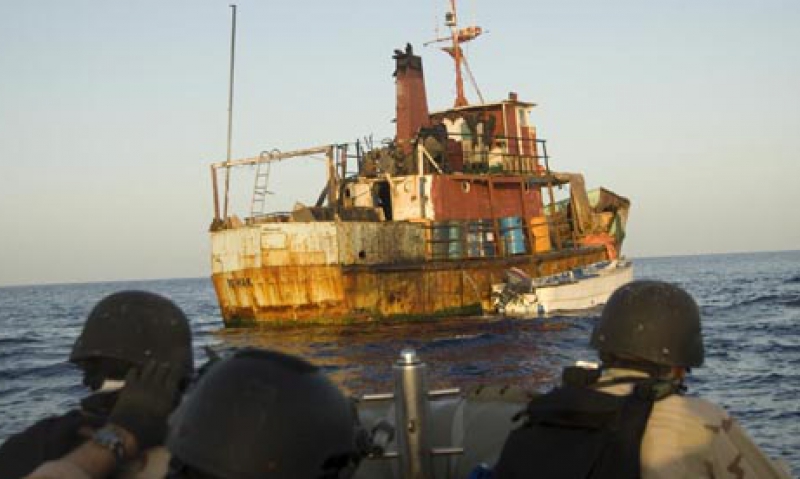
Perspective on piracy
Pirates are the stuff of legend to most of us. But pirates are very real, and they continue to cause death and destruction on the high seas.
This is especially true in the lawless waters around the Horn of Africa. Tallies kept by the International Maritime Bureau’s Piracy Reporting Center indicate that pirates operating in the Gulf of Aden and off the Somali coast have attacked at least 75 ships so far in 2010. This follows attacks on 214 ships in 2009, 111 in 2008 and 55 in 2007. Between 2003 and 2007, by way of comparison, there were just 15 pirate attacks in the region annually. In short, the problem isn’t going away and could be getting worse.
Moreover, piracy – even in the faraway waters between Somalia and Yemen – ultimately impacts all of us. “Piracy,” according to David Shinn, former U.S. ambassador to Ethiopia, “has caused insurance premiums for a single transit through the Gulf of Aden to rise from as low as $500 to as much as $20,000.”
To avoid the pirates and the insurance costs, some cargo lines are choosing different routes, increasing total distance traveled by as much as 38 percent. Other shippers are sending goods by air, which costs up to 10 times as much as seaborne transport. These “piracy surcharges” are being passed on to consumers.
There’s also the very real danger to national security. In 2008, pirates hijacked a Kenya-bound freighter loaded with dozens of T-72 battle tanks. This year, they captured a tanker carrying poisonous chemicals.
The return of high-profile piracy is worrisome, to be sure, but we would do well to keep it in perspective.
Given that between 22,000 and 30,000 ships sail the Gulf of Aden annually, as a recent U.S. government report concludes, “The overall risk of attack, even off the Somali coast is relatively low.”
How low? A vessel runs a 0.167-percent chance of being attacked or seized by pirates in and around the Gulf of Aden.
In short, many cargo lines are literally taking their chances, calculating that the costs of piracy countermeasures – such as traveling via safe corridors, deploying water hoses to thwart attacks and lining decks with barbed wire – outweigh the risks of being captured by pirates.
In addition, the world has weathered worse outbreaks of piracy. The Congressional Research Service (CRS) reports there were 3,000 pirate attacks in the Caribbean between 1815 and 1823. The U.S. Navy responded in Puerto Rico, Cuba, Spanish Florida and the Yucatan. Nor was the pirate plague quarantined to this hemisphere. CRS reminds us that between 1801 and 1855, U.S. forces carried out anti-piracy missions in Tripoli, Algiers, Greece, Sumatra, Ivory Coast and Hong Kong.
Just as history offers perspective on piracy, it also offers lessons on how to combat this ancient plague of the seas.
Today, the U.S. Navy is leading a NATO armada under the codename “Ocean Shield.” This counter-piracy task force operating off the Horn of Africa and in the Gulf of Aden was recently extended through the end of 2012. Naval forces from the European Union, Japan, India, Russia and China are also contributing to the counter-piracy coalition, and Kenya has agreed to hold and prosecute some captured pirates.
Shinn notes that the military has been ordered to handle piracy “as a criminal problem, not a military one.” He likens warships on station to “a county jail.”
In fact, the documentary film “U.S. Navy: Pirate Hunters” reports that some warships are outfitted with police-style sirens. Just like cops on the beat, U.S. sailors chase, apprehend, fingerprint and then often release pirates due to lack of evidence. They are not permitted to destroy the mother ships or coastal nests that spawn the pirates.
Sailors aboard the USS Gettysburg jokingly call their ship “Hotel Gettysburg” due to the generous hospitality they offer the Somalis – and the constrictive, self-defeating rules of engagement and detention under which the coalition operates.
How constrictive and self-defeating? According to Shinn, “U.S. personnel do not interrogate the suspects because Kenyans only accept confessions done in front of Kenyan magistrates.”
And even when they make it to trial, the pirates turn the proceedings into a farce. For example, after using RPGs to attack a Dutch-flagged cargo ship in 2009, Somali pirates were captured by Dutch marines, taken to the Netherlands to stand trial and promptly claimed that the Dutch cargo ship had attacked them during a fishing outing.
The Somalis were found guilty and sentenced to five years in prison, but now European officials are worried about convicted pirates seeking asylum after serving out their sentences.
Historically, pirates weren’t afforded the protections of law. Because pirates used their very lawlessness and statelessness as weapons – they were known as “enemies of humanity” for good reason – our forebears had the sense to recognize that pirates didn’t deserve the protections of the law or the state. So they hunted down pirates, destroyed their bases and destroyed their vessels.
That may be too uncivilized for the 21st century, but surely there is something better than today’s catch-and-release arrangement.
